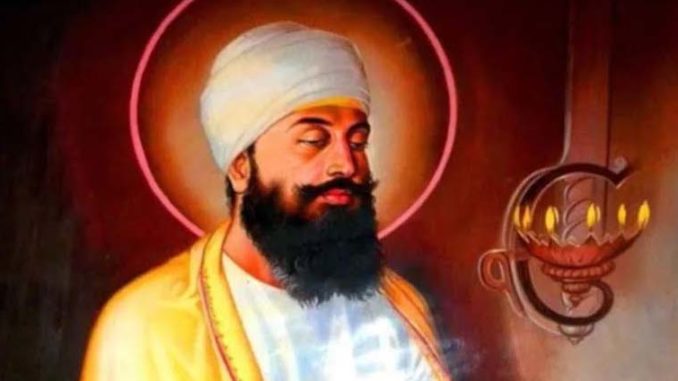

The martyrdom of Guru Tegh Bahadur, the Ninth Master of the Sikhs, remains one of the most exalted episodes in human history—an event that transcends the boundaries of time, geography, and community. It is not merely a moment recorded in annals; it is a moral force that continues to shape the world’s understanding of conscience, human rights, and the sacred value of pluralism. Three and a half centuries after his execution in Delhi in 1675, his sacrifice commands not only reverence but deep reflection, for its relevance in the modern global context is as profound as it was in the India of Aurangzeb’s reign.
To understand why, we must return to the historical landscape in which his martyrdom took place. In the late 17th century, Mughal Emperor Aurangzeb had intensified policies of religious coercion aimed at homogenizing the empire under Islamic law. Hindus, particularly the Kashmiri Pandits, faced aggressive pressure to convert. Their temples were destroyed, their scholars persecuted, and the dread of conversion hovered over the community like a dark cloud. In desperation, a delegation of Kashmiri Brahmins reached Anandpur Sahib and appealed to Guru Tegh Bahadur for protection. Their plea was not for political autonomy or economic relief but for the most fundamental of human entitlements: the right to practice their religion freely.
Guru Tegh Bahadur recognized instantly that the struggle was not merely the plight of one community; it was a defining test of whether the individual conscience could prevail against state power. His response was unequivocal. By deciding to stand against forced conversions and offering himself up as the moral challenger to Aurangzeb’s policies, he affirmed a universal principle: faith must be an act of free will, not submission. This singular act of resistance would go on to transform the trajectory of Indian history.
Upon reaching Delhi and refusing to accept Islam, he faced months of imprisonment, torture, and threats. The executions of his companions—Bhai Mati Das, Bhai Sati Das, and Bhai Dayala—were meant to break his resolve. Yet the Guru remained unshaken. His martyrdom on November 24, 1675, by beheading in Chandni Chowk, was a watershed moment. The Mughal Empire hoped to stifle dissent through this brutal spectacle. Instead, it ignited a fire of resistance and spiritual awakening across India.
Martyrs do not simply belong to history; they create and reshape it. Guru Tegh Bahadur’s sacrifice undermined the moral legitimacy of Aurangzeb’s coercive policies, inspired grassroots defiance against tyranny, and ultimately contributed to the weakening of Mughal authority. It also prepared the ground for the rise of Guru Gobind Singh and the formation of the Khalsa, a force that would challenge imperial aggression with spiritual strength and armed resistance.
But the significance of Guru Tegh Bahadur’s martyrdom extends far beyond the boundaries of his time. It was, in essence, a declaration of religious freedom—a concept that modern constitutions and international human rights frameworks have now enshrined, but which was scarcely acknowledged in the political philosophies of the 17th century. Long before the world recognized the right to faith in the Universal Declaration of Human Rights (1948), Guru Tegh Bahadur upheld it with the ultimate sacrifice of his life.
His legacy anticipated a world order in which religious freedom, human dignity, and freedom of conscience are recognized as foundational values. In the modern global landscape, where intolerance, majoritarianism, and religious persecution continue to surface in various forms, his martyrdom holds a mirror to humanity. It compels societies to reflect: Are we living up to the ideals he died defending?
Today, nations around the world grapple with challenges that echo the dilemmas of his era. In certain regions, religious minorities still face threats to their identity and survival. Governments legislate matters of belief. Communities clash over ideologies. Extremist movements attempt to impose singular narratives. In such a world, Guru Tegh Bahadur’s life and sacrifice assert a universal and timeless message: the conscience of an individual is sacred, and the right to faith cannot be dictated by rulers, mobs, or majorities.
This is why he came to be revered as Hind ki Chadar—the Shield of India. He did not fall defending his own religion but safeguarding the faith of another. His martyrdom was an expression of the highest moral courage—a level of ethical clarity that remains a benchmark for humanity. The modern world, with all its technological advancements and evolving political systems, still struggles to embody this ethos.
The power of his example lies in its breadth. Guru Tegh Bahadur’s message is not confined to Sikhs or Indians; it is universal. In an era where societies debate the limits of tolerance, free expression, and cultural diversity, his sacrifice underscores a fundamental truth: pluralism is not a burden but a civilizational strength. Upholding the rights of others—even when their beliefs differ from one’s own—is not just moral duty but the foundation of peaceful coexistence.
Indeed, one of the most remarkable aspects of his martyrdom is that it defended a community whose faith, customs, and theology were distinct from his own. The Kashmiri Pandits practiced a faith different from Sikhism, yet their right to worship was sacred in Guru Tegh Bahadur’s eyes. His sacrifice speaks directly to a contemporary world where polarization is increasing and empathy shrinking. He teaches us that humanity must rise above identity and serve the universal principles of justice.
The moral hierarchy expressed by the distinguished Sikh leader Master Tara Singh beautifully captures the spirit of Guru Tegh Bahadur’s life:
Blessed is the one who gets to serve others.
More blessed is the one who serves their faith.
Even more blessed is the one who serves another’s faith.
Greater still is the one who protects another’s religion.
The greatest is the one who gives their life for another’s religion.
It is in this final, most exalted ideal that Guru Tegh Bahadur stands alone in world history. He did not die for territory, power, or his community’s privilege. He died for the right of others to retain their identity, their scriptures, their temples, and their conscience. His martyrdom represents the pinnacle of spiritual altruism.
As the global community confronts new forms of intolerance—whether digital manipulation of identities, persecution of minorities, cultural erasure, or ideological extremism—Guru Tegh Bahadur’s example offers a path forward. It reminds nations that progress without values is hollow, and development without freedom is fragile. It urges individuals to stand for justice even when the cost is high, to defend the rights of others even when they are different, and to recognize that conscience is the greatest sovereign.
Guru Tegh Bahadur’s martyrdom is therefore not just a golden chapter in human history; it is a living beacon for the present and a guide for the future. It invites the world to rediscover the profound strength that lies in moral courage. It challenges humanity to uphold the right to faith, resist oppression, and cherish diversity. And above all, it teaches that the noblest expression of humanity is the willingness to stand for another’s freedom—even at the cost of one’s own life.





Be the first to comment